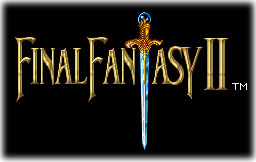
 |
|
The first Final Fantasy game for the Super Nintendo, Final Fantasy IV (released in North America as Final Fantasy II), is a flashpoint for RPG lovers' opinions. For the most part, those who played it when it was new remember it fondly. More recent RPG fans tend to think of the game as primitive; the graphics, characterization, and magic systems are often cited as poor. In comparison to RPGs released in the past few years, that may be true; but at the time, Final Fantasy IV excelled in every category. The game revolves around a young man named Cecil, a Dark Knight and captain of the Red Wings. The Red Wings are an airborne military strike force for the kingdom of Baron that has been ordered to take a crystal from the people of the magical city of Mysidia at any cost. But the king has not told them why the crystal must be captured, and the once-proud Red Wings wonder to their captain why the king has turned them into little more than thieves. Cecil has no answer. When he dares to question his liege, he and his friend Kain are released from their duties and sent out into the world on what seems to be an inconsequential mission. Soon, they find that the king is up to something far more insidious and they decide to put an end to it. Cecil's journey to set things right again sends him across the world, to a land far underground, and even to the moon.
Cecil is cut from the same cloth as later Final Fantasy heroes Cloud and Terra -- a man working for an evil organization who sees the error of his ways and tries to stop, while finding out more about his mysterious past. It may be old hat and fairly cliched now, but Cecil was the first of this character type to appear in the series. Many of the other characters received little development or background during the course of the game; but in previous games, characters had no development whatsoever. In FF IV, characters not only had given names, but personalities, love interests, and emotions. Rosa's love for Cecil, Edward's will to help his friends, and Kain's jealousy all made for a more emotional and involving story than had been seen in an RPG before. In a way, FFIV was one of our first glimpses at the beginnings of the trends that led to the more cinematic RPGs we're familiar with today.
16-bit technology was fairly new at the time, so programmers had not found the best ways to take full advantage of the superior graphics power. Scenery was simple and sprites were small and vague, but the wider range of colors, layer effects, and multi-levelled settings created a detailed and enchanting world. Gamers who had seen the opening "bridge-crossing" screen of FF I were dazzled by the the similar scene in IV, when Cecil and Kain leave Castle Baron on their mission. The nostalgia was only heightened by the music during the sequence; we hear the same song that played in the original, only better arranged for the sound capabilities of the SNES. Seldom do gamers complain about the music. Many of Nobuo Uematsu's most popular works are found on this game's soundtrack, including Rosa's "Theme of Love", "The Dreadful Battle", and the first North American appearance of the chocobo theme. Perhaps the most widely known and loved version of the main FF theme appeared here as well, as part of the long medley that played during the ending.
The translation is a major point of contention among fans. Though the important dialogue was mostly handled well, there are awkward moments scattered throughout the game. "Misty Valley is beyond the cave of northwest." "Wow! You noble looking!" "Fighting when mist will freeze you with breath!" And, of course, the rallying cry of unusual translation fans and foes everywhere, Tellah's renowned "You spoony bard!" There's no doubt the translation was somewhat shoddy; depending on your feelings towards awkward translations, it can make the game either a disaster or incredibly amusing.
Throughout the game, fans of the first Final Fantasy were rewarded with nods to the original as they witnessed future trends beginning. Again the setting was a low-tech world mixed with occasional high technology. Within this world, elemental fiends, a very familiar-looking airship, the Rat's Tail, a thieving dark elf, and the king of Dragons, Bahamut, all made a return appearance. It even had the marvelously wussy imps that appeared in FFI. And once again, one of the most powerful spells was Nuke. (And it was still fun to cast on imps for the sheer joy of overkill!) Certain now tried and true traditions appeared for the first time: chocobos, Leviathan, and the elemental summons of Djinn, Shiva, and Ramuh, who was called Indra at the time, but clearly is the same character. The most powerful, sought-after spell was Meteo just as FFVII's was Meteor, except with a limit of 5 characters in the name. In a way, FFIV was a bridge between the old style of RPGs and the new; the silent, obedient casts of most 8-bit RPGs, and the emotionally diverse casts of more recent offerings. The main FF theme, often called "the bridge-crossing theme", fit perfectly into both the beginning and the ending of this game -- and perhaps, given the role of this game in the basic development of the FF series, it's not surprising. Retrospective by Andrea Hartmann. |
|
|||||||||||||||||||||||||||||||||||||||||||||||





